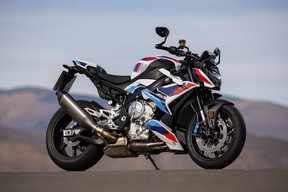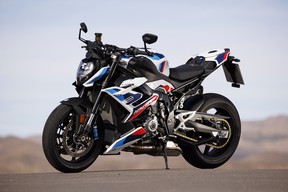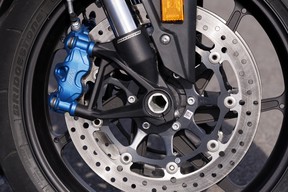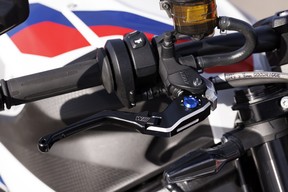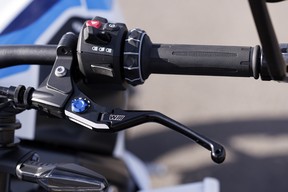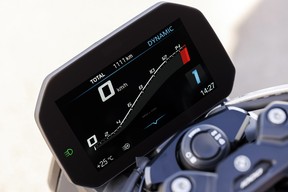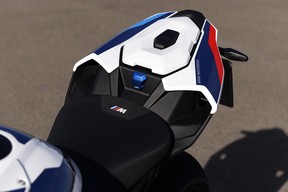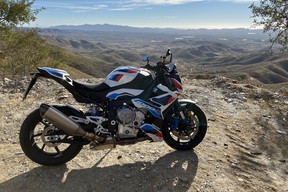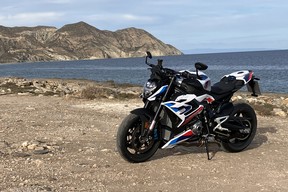BMW refreshes the S 1000 RR and introduces the M 1000 R for 2023, two potent sporting motorcycles ready for the road and track

Article content
A quick glance at the speedometer was displaying 282 kilometres an hour before I hit the brakes hard for the upcoming right-hand turn — and that was in just the fifth of six gears. Hold the hate mail; this was not — nor should it ever be — on a public road. It was at the end of the 970-metre-long back straight at Spain’s 4.2-km-long Almeria Circuit, during the press intro of the 2023 BMW S 1000 RR. BMW has revised its flagship sport bike for 2023, and the changes have made what was already a potent supersport machine even better.
Advertisement 2
Article content
The S 1000 RR’s 205-horsepower, 999 cc inline four has been updated with a new cylinder head and revised gearbox ratios. The cylinder head now has the same intake port design as on the higher-spec M 1000 RR (and much pricier at $43,260 versus $20,395 for the S), but the ports are cast into the head rather than being machined as on the M. The engine produces 83 lb-ft of torque at 11,000 rpm, and redlines at 14,600 rpm. Overall gearing has been lowered by adding a tooth to the rear sprocket.
Advertisement 3
Article content
Cradling the engine is a new frame that has more flex engineered into its beams (which actually improves handling when applied properly). The steering geometry has been altered for more stability, wheelbase is 18-mm-longer at 1,458 mm, and the swingarm pivot and rear ride height are now adjustable to allow fine tuning of the chassis at the track.
Visually, however, the biggest change, the one that has all the diehard sportbikers talking, is the addition of MotoGP-inspired fairing winglets. These winglets generate up to 17 kg of downforce at speed, reducing the risk of lifting a wheel (and when you have 205 horses available on a light two-wheeler, an unwanted wheelie is always a concern). The tailpiece has also been redesigned, incorporating a more compact licence-plate and turn-signal bracket that is easily removable for racetrack outings.
Advertisement 4
Article content
-
![So, you wanna learn to ride a motorcycle]()
So, you wanna learn to ride a motorcycle
-
![Motor Mouth: Riding a horse is more dangerous than riding a motorcycle]()
Motor Mouth: Riding a horse is more dangerous than riding a motorcycle
Wet weight is a svelte 197 kg, which is only four kilos more than the M 1000 RR; if you add the optional M package ($6,125), which includes among other things, machined footpegs and carbon-fibre wheels, the S 1000 RR’s weight drops to within a half kilo of the M. Our test bikes were equipped with the M package.
The standard suspension is manually adjustable, while the optional Dynamic Damping Control (DDC) semi-adaptive suspension is electronically adjustable, either through the different ride modes, or independently through the instrument panel. Both the standard and DDC suspension are fully adjustable.
Advertisement 5
Article content
Advertisement 6
Article content
The S 1000 RR showcases the latest in electronic rider aids. It comes with four standard ride modes, lean-sensing ABS and traction control, a quick shifter, and hill-start assist as standard. Our test bikes were equipped with the optional, racetrack-oriented Dynamic package ($1,915), which includes the DDC suspension, three track-dedicated Race Pro ride modes, wheelie control, launch control, a pit-lane speed limiter, and new this year, slide control and brake slide control; the former controls rear-wheelspin to allow the bike to slide out of corners on the gas, while the latter controls the rear brake and engine braking to allow the bike to slide into corners. The ABS also has a “slick” setting when fitting race tires to the bike.
Advertisement 7
Article content
Some open-class supersport machines are incredibly fast on a racetrack, but are mentally and physically demanding to ride hard. Five track sessions revealed that while the S 1000 RR is as fast they come, it has neutral handling and advanced electronics that make it forgiving and easy to ride — easy for an expert rider; riders with less experience should look elsewhere before stepping onto an open-class supersport machine, even on the racetrack.
The new slide control was really noticeable in the later sessions, after the race slicks that were installed for the track began giving up some of their grip. With this feature set to minimum, I’d open the throttle to the stop at just past the apex of the fast right-hand turn before the long back straight, and the rear would kick out just a bit and stay there until the bike straightened out. A higher setting would have allowed the rear to swing out more, at the cost of some speed and more tire wear. Ideally, no slip is ideal for quick lap times; the slide control is really designed more to make you look fast. Trust the electronics and you’ll look like you’re a MotoGP star.
Advertisement 8
Article content

The M 1000 R, also launched at this event, is a higher-spec variation of the S 1000 R naked bike. Usually, manufacturers detune naked bikes that are based on their sport bikes. BMW did it with the S 1000 R; it produces 40 fewer horses than the S 1000 RR we’ve just been talking about. BMW has not, however, toned down the M 1000 R, offering it with the same engine and in the same 205-horsepower tune as the S 1000 RR.
The M 1000R also much pricier, at $25,495 ($16,500 for the S), but it comes with every available option you can get for the S 1000 R, as well as the S 1000 RR’s advanced racetrack electronics. Standard items include DDC suspension, Pro ride modes, track-ready traction control and ABS, wheelie control, slide control, dynamic brake control, quick shifter, forged wheels, machined levers, and many more standard items. Adding all of these to the S 1000 R would likely raise its price to near the M’s price, and you’d still be down 40 horsepower.
Advertisement 9
Article content
The M 1000 R is a better option than the S 1000 RR supersport if you prioritize street riding over track lapping, as it has a more upright — read more comfortable — riding position. It has even shorter gearing than on the RR, and pulls even harder, a feeling further emphasised by its upright riding position. The shorter gearing does allow the engine to spin higher, which makes the bike buzzier at highway speeds, but the added vibes are not intrusive.

A quick stint on the racetrack revealed that its wider, taller handlebar actually makes it more fun to ride than the S 1000 RR. It’s actually easier to throw into turns, but of course, since it lacks the streamlining of the RR’s fairing, you have to fight the wind at speed. But performance-wise, it is as capable as the S 1000 RR, since it is essentially the same machine without the bodywork.
Advertisement 10
Article content
When BMW introduced the S 1000 RR in 2009, it set the benchmark in supersport performance and in electronic riding aids, having been the first manufacturer to offer a bike in Canada with selectable ride modes, ABS and traction control as standard. BMW eventually dropped one R from the name, pulled off the fairing, and offered a slightly tamer naked bike based on the RR — the new, unrestricted M is not so tame. The German bike maker hasn’t been resting on its laurels, and for 2023; both S 1000 RR superbike and M 1000 R naked bike remain at the pinnacle of high performance.
Both machines will be arriving at showrooms in January 2023.
Stay connected with us on social media platform for instant update click here to join our Twitter, & Facebook
We are now on Telegram. Click here to join our channel (@TechiUpdate) and stay updated with the latest Technology headlines.
For all the latest Automobiles News Click Here

